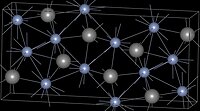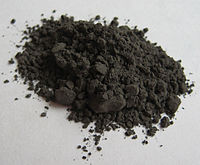Hrom karbid
Hrom karbid je organsko jedinjenje, koje sadrži 2 atoma ugljenika i ima molekulsku masu od 188,073 Da.

| |

| |
| Nazivi | |
|---|---|
| IUPAC naziv
Chromium(II) carbide
| |
| Drugi nazivi
Chromium carbide
| |
| Identifikacija | |
3D model (Jmol)
|
|
| ChemSpider | |
| ECHA InfoCard | 100.031.420 |
| |
| Svojstva | |
| Cr3C2 | |
| Molarna masa | 180,009 g/mol |
| Agregatno stanje | gray orthorhombic crystals |
| Gustina | 6,68 g/cm3 |
| Tačka topljenja | 1.895 °C (3.443 °F; 2.168 K) |
| Tačka ključanja | 3.800 °C (6.870 °F; 4.070 K) |
| reacts | |
| Struktura | |
| Kristalna rešetka/struktura | Orthorhombic, oP20 |
| Kristalografska grupa | Pnma, No. 62 |
| Opasnosti | |
| NFPA 704 | |
| SAD zdravstvene granice izlaganja (NIOSH): | |
PEL (dozvoljivo)
|
TWA 1 mg/m3[4] |
REL (preporučeno)
|
TWA 0.5 mg/m3[4] |
IDLH (neposredna opasnost)
|
250 mg/m3[4] |
Ukoliko nije drugačije napomenuto, podaci se odnose na standardno stanje materijala (na 25 °C [77 °F], 100 kPa). | |
| Reference infokutije | |
Osobine
уреди| Osobina | Vrednost |
|---|---|
| Broj akceptora vodonika | 0 |
| Broj donora vodonika | 0 |
| Broj rotacionih veza | 0 |
| Particioni koeficijent[5] (ALogP) | 2,8 |
| Rastvorljivost[6] (logS, log(mol/L)) | 3,0 |
| Polarna površina[7] (PSA, Å2) | 0,0 |
Reference
уреди- ^ Lide, David R. (1998), Handbook of Chemistry and Physics (87 изд.), Boca Raton, Florida: CRC Press, стр. 4—52, ISBN 0-8493-0594-2
- ^ Li Q, Cheng T, Wang Y, Bryant SH (2010). „PubChem as a public resource for drug discovery.”. Drug Discov Today. 15 (23-24): 1052—7. PMID 20970519. doi:10.1016/j.drudis.2010.10.003.
- ^ Evan E. Bolton; Yanli Wang; Paul A. Thiessen; Stephen H. Bryant (2008). „Chapter 12 PubChem: Integrated Platform of Small Molecules and Biological Activities”. Annual Reports in Computational Chemistry. 4: 217—241. doi:10.1016/S1574-1400(08)00012-1.
- ^ а б в NIOSH Џепни водич хемијских хазарда. „#0141”. Nacionalni institut za bezbednost i zdravlje na radu (NIOSH).
- ^ Ghose, A.K.; Viswanadhan V.N. & Wendoloski, J.J. (1998). „Prediction of Hydrophobic (Lipophilic) Properties of Small Organic Molecules Using Fragment Methods: An Analysis of AlogP and CLogP Methods”. J. Phys. Chem. A. 102: 3762—3772. doi:10.1021/jp980230o.
- ^ Tetko IV, Tanchuk VY, Kasheva TN, Villa AE (2001). „Estimation of Aqueous Solubility of Chemical Compounds Using E-State Indices”. Chem Inf. Comput. Sci. 41: 1488—1493. PMID 11749573. doi:10.1021/ci000392t.
- ^ Ertl P.; Rohde B.; Selzer P. (2000). „Fast calculation of molecular polar surface area as a sum of fragment based contributions and its application to the prediction of drug transport properties”. J. Med. Chem. 43: 3714—3717. PMID 11020286. doi:10.1021/jm000942e.
Literatura
уреди- Clayden, Jonathan; Greeves, Nick; Warren, Stuart; Wothers, Peter (2001). Organic Chemistry (I изд.). Oxford University Press. ISBN 978-0-19-850346-0.
- Smith, Michael B.; March, Jerry (2007). Advanced Organic Chemistry: Reactions, Mechanisms, and Structure (6th изд.). New York: Wiley-Interscience. ISBN 0-471-72091-7.
